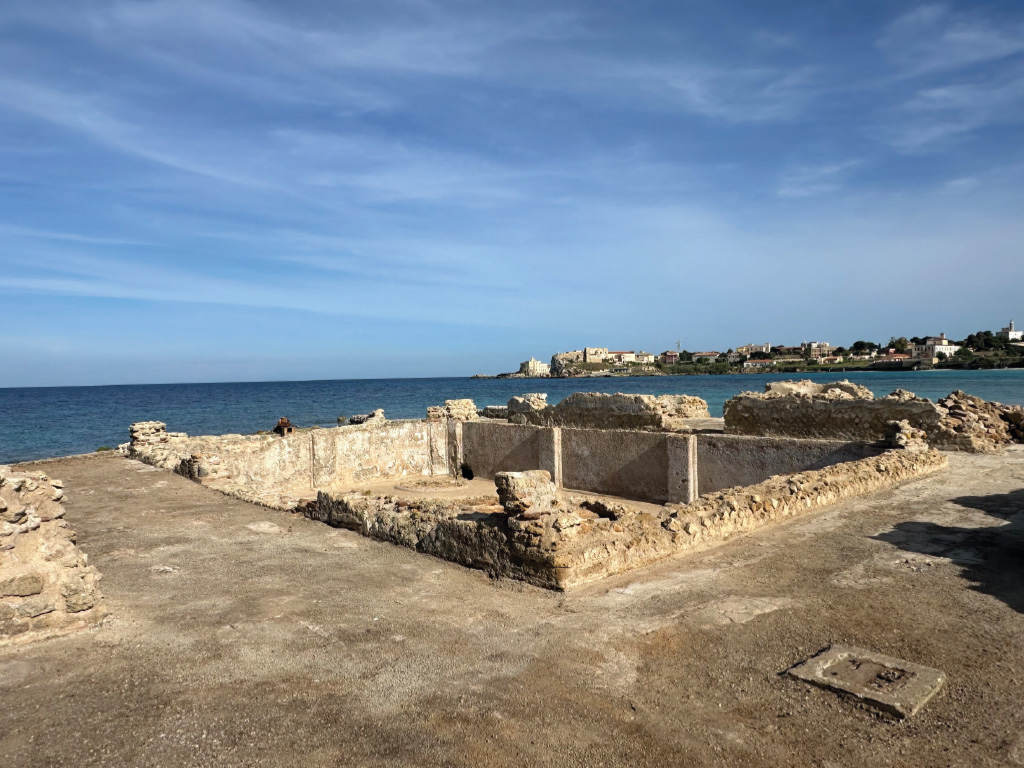L’Arcipelago toscano è costellato di ville marittime di epoca romana, incastonate su alte scogliere o adagiate lungo i rilievi, nate tra I sec. a.C. e I sec. d.C. e poche sopravvissute oltre il III secolo. Queste dimore di otium, destinate all’élite romana e spesso alla famiglia imperiale, erano luoghi di lusso e bellezza, con sale da banchetto, rivestimenti in marmo, stucchi, mosaici, piscine e giochi d’acqua, immerse in giardini che univano arte e natura. L’Isola d’Elba ospita importanti complessi, come la Villa delle Grotte e il sito termale della Linguella a Portoferraio, entrambi con pavimenti a tarsie e mosaici, oggi parzialmente ricostruiti nel Museo Archeologico. A Capo Castello, a Rio, restano ambienti decorati, mentre Pianosa conserva il Bagno di Agrippa, rifugio dorato del nipote di Augusto. A Gorgona, l’area di Limiti mostra resti affacciati su terrazzamenti, con pitture e mosaici. A Capraia, la villa al porto ha restituito materiali di pregio, tra cui vetri e ceramiche; a Giannutri restano imponenti colonne e ambienti del grande complesso residenziale. Al Giglio, le strutture della villa del Saraceno giacciono nascoste dal mare e dal paese. Una mostra a Rosignano Marittimo, inaugurata il 21 dicembre 2024, espone i reperti più importanti, in attesa del catalogo bilingue che racconti con immagini e testi la storia di questi luoghi straordinari.
The Tuscan Archipelago has many maritime villas from Roman times, mostly from the Augustan period (1st century BC to 1st century AD), and only a few remained active into the 3rd century. Built on cliffs or hillsides, these luxurious residences featured banqueting halls, marble floors and walls, mosaics, stuccoed ceilings, fountains and vast gardens where Roman artistry met the natural beauty of the islands. Notable examples include Le Grotte and the thermal complex of La Linguella in Portoferraio (Elba), the Roman villa at Capo Castello (Rio), the Bagno di Agrippa on Pianosa, the villa at Limiti on Gorgona, the harbour villa on Capraia, and Giannutri’s monumental structures. A few remain hidden, such as the villa of Il Saraceno on Giglio. The most important archaeological finds from these villas are now showcased in a temporary exhibition at the Civic Archaeological Museum in Rosignano Marittimo, opened on 21 December 2024, and a bilingual catalogue is forthcoming.
Das Toskanische Archipel ist reich an römischen Villen, die vor allem in der augusteischen Epoche (1. Jh. v. Chr. bis 1. Jh. n. Chr.) entstanden sind. Nur wenige blieben bis ins 3. Jh. bewohnt. Diese luxuriösen Wohnsitze, oft auf Klippen oder Hügeln gelegen, verfügten über prächtige Säle, mit Marmor verkleidete Böden und Wände, Mosaike, Stuckdecken, Brunnenanlagen und weitläufige Gärten, in denen sich Baukunst und Landschaft vereinten. Bedeutende Anlagen sind die Villa delle Grotte und das Thermengebäude der Linguella in Portoferraio (Elba), die Villa in Capo Castello (Rio), das Bagno di Agrippa auf Pianosa, die Villa in Limiti auf Gorgona, die Hafen-Villa auf Capraia sowie die monumentalen Reste auf Giannutri. Am Giglio hingegen sind die Überreste der Villa del Saraceno vom Meer und modernen Bauten überdeckt. Die wichtigsten Funde sind in einer Sonderausstellung im Archäologischen Museum von Rosignano Marittimo zu sehen (Eröffnung: 21. Dezember 2024), ergänzt durch einen zweisprachigen Ausstellungskatalog mit Bildern und Texten.

